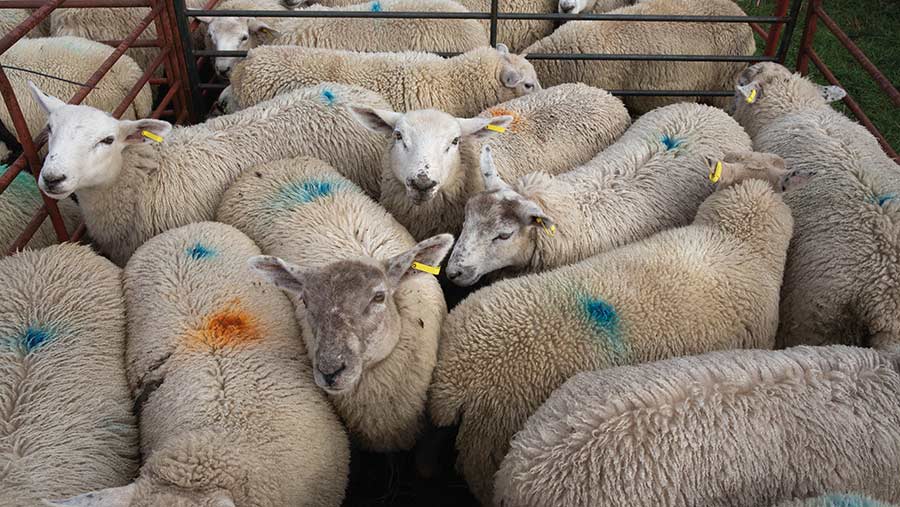Strong start to store lamb sale season
 © Tim Scrivener
© Tim Scrivener Store lamb sales are seeing strong demand off the back of a firm finished trade and plentiful grass. Weekly store numbers are rising as the sales season gets under way, and the dip in the finished lamb price a couple of weeks ago saw some store buyers around the primestock rings to pick up extra numbers.
At Longtown, Cumbria, auctioneer John Walton sold just under 3,500 store lambs on Tuesday, 10 August, at an average of £87-£88 a head. This was £7-£9 a head up on the previous week’s sale, thanks to a recovery in finished prices at the start of the week.
The trade saw Beltex-cross store lambs most in demand and making £105-£112 a head, said Mr Walton. Strong Mules were in the late £80s a head, with commercial Suffolk- and Texel-crosses in the same range.
Tight lamb supply
In terms of the outlook for finishing those store lambs, several factors point to a continued tightness in primestock supply through the autumn and into next year, say auctioneers.
See also: Silvopasture – what it is and how it benefits livestock farming
These include the strong finished price encouraging sales of lambs earlier and at lighter weights through the season so far, reducing the overall potential sheepmeat supply.
A good number of these would have been gimmer lambs that would usually be kept back as replacements.
The AHDB forecasts that lamb slaughter numbers in the second half of this year will be 4% lower than July-December last year. However, it says this will be balanced by higher slaughterings in the first half of 2022.
“Lambs had a difficult start in the dry spring and didn’t thrive, which pushed prices up,” said Mr Walton. “But farmers have got on top of their lambs now and if the price dips, they can just shut the gates and make them a bit heavier – the farmers are in control.”
Auctioneer Elfor Morris at Ruthin Farmers Auction Company had 1,000 head booked for a sale on Thursday 12 August and was expecting an average in the mid £80s a head for short-keep lambs.
Ruthin’s previous sale of 700 store lambs (5 August) saw the strongest short-keep lambs at £85-£90, with longer-keep cross-bred lambs from £60-£70. The strongest Welsh lambs made to £55 a head, with lighter lambs from £30 to £50.
The sale of finished lambs at lighter weights so far this season will serve to tighten supply further, said Elwyn Davies of Hobbs Parker at Ashford, where 5,000 store lambs were booked for a sale on Friday 13 August. This is slightly down on the number at the same sale last year, when the drought forced earlier sales of stores than producers would have liked. Mr Davies said the strong finished prices and plentiful keep would make for a strong store trade.
Lamb demand pointers
- Lamb slaughter numbers in July to December forecast 4% lower than the same time last year, balanced by higher expected slaughtering in the first half of 2022
- Uncertainty over speed of recovery of hospitality demand, but continued high level of takeaway and delivered meals supports lamb sales
- EU consumer demand slightly dampened by pandemic
- EU sheepmeat production forecast steady this year, with consumption set to fall 1.2%
- Supply of Australian and NZ lamb tight this year – NZ production down 4%; Australia steady – with both looking to rebuild flocks after droughts
- Uncertainty about ewe numbers for next year’s breeding flock – the AHDB reports divergence between Defra slaughter statistics and livestock market cull ewe throughputs
- Anecdotal evidence of small rise in breeding flock for 2022 lambing, but the AHDB says a rise of more than 2% would be very unusual
